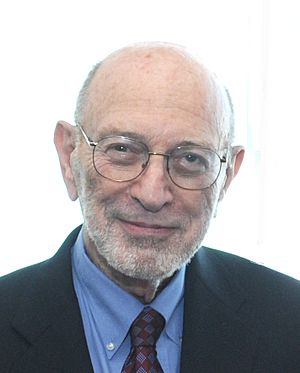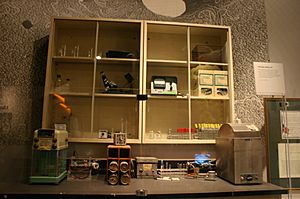Stanley Norman Cohen facts for kids
Quick facts for kids
Stanley Norman Cohen
|
|
|---|---|

Stanley Norman Cohen, 2016
|
|
| Born | February 17, 1935 |
| Nationality | American |
| Alma mater | Rutgers University, University of Pennsylvania |
| Spouse(s) | Joanna Lucy Wolter |
| Awards | National Medal of Science, Wolf Prize in Medicine |
| Scientific career | |
| Fields | Genetics |
| Institutions | Stanford University |
| Doctoral students | Kelly Ten Hagen |
Stanley Norman Cohen (born February 17, 1935) is an American geneticist famous for his work in medicine and science. He is a professor at the Stanford University School of Medicine.
Along with fellow scientist Herbert Boyer, Cohen was one of the first people to move genes from one living thing to another. This amazing discovery was a key step in creating the field of genetic engineering. Their work has led to thousands of important products, like human growth hormone and the hepatitis B vaccine.
Many scientists believe Cohen's work changed biology forever. Immunologist Hugh McDevitt said that Cohen's technology has helped scientists in almost every field. Without it, modern medicine and biotechnology would be completely different.
Contents
Early Life and Education
Cohen was born in Perth Amboy, New Jersey. He was a bright student who went on to study science and medicine. He earned a bachelor's degree from Rutgers University in 1956. After that, he received his medical degree from the University of Pennsylvania in 1960.
After medical school, Cohen worked and trained at several hospitals. He decided he wanted to combine his work as a doctor with scientific research. In 1968, he joined the team at Stanford University and began his long and successful career there.
A Groundbreaking Discovery
At Stanford, Cohen became interested in plasmids. Plasmids are small, circular pieces of DNA found in bacteria. He wanted to understand how plasmids could make bacteria resistant to antibiotics. This research would lead him to his most famous discovery.
Meeting Herbert Boyer
In 1972, Cohen went to a science conference about plasmids. There, he met another scientist named Herbert Boyer. They quickly realized that their research interests fit together perfectly. They decided to work together, combining their skills and knowledge.
Their teams at Stanford and the University of California, San Francisco began to collaborate. Cohen's team would prepare the plasmids and send them to Boyer's team. Boyer's team used a special tool called a restriction enzyme to cut the plasmids. The pieces were then sent back to Stanford, where Cohen's team put them back together in new ways.
The Famous Experiment

In 1973, Cohen and Boyer performed one of the first genetic engineering experiments. They wanted to see if they could take a gene from a frog and put it into a bacterium.
First, they created a special plasmid called pSC101. This plasmid was their vector, which is like a tiny delivery truck for genes. It had a gene that made bacteria resistant to an antibiotic called tetracycline.
They used a restriction enzyme to cut both the frog DNA and the pSC101 plasmid. This created "sticky ends" on the DNA pieces, which allowed them to easily join together. Using another tool called DNA ligase, they attached the frog gene into the plasmid.
Finally, they put these new, combined plasmids into Escherichia coli bacteria. The bacteria that successfully took in the new plasmid were able to grow in a dish containing tetracycline. This experiment proved that a gene from an animal could be put into a bacterium, and the bacterium would use it.
The Birth of Genetic Engineering
The work of Cohen and Boyer was a huge breakthrough. Their 1973 scientific paper is seen as a major moment in science. It showed that scientists could combine genes from different sources and make living cells copy them. This was the beginning of genetic engineering.
Later experiments showed that genes could even be moved between different species of bacteria. These discoveries opened up a whole new world of possibilities in medicine and biology. For this work, Cohen received many awards, including the prestigious Albert Lasker Award for Basic Medical Research in 1980.
Lasting Impact
Cohen and Boyer's discovery had a massive impact. The process they invented was patented, and hundreds of companies licensed the technology. This led to the creation of thousands of products that have helped people all over the world.
Their work also showed universities that scientific research could have great commercial value. It inspired a new wave of innovation in the field of biotechnology. Today, Cohen continues his research at Stanford. He studies how genes move between bacteria and how cells grow and develop.
Awards and Recognition
Throughout his career, Stanley Norman Cohen has received many honors for his scientific contributions.
- 1979 elected to the National Academy of Sciences
- 1980 Albert Lasker Award for Basic Medical Research
- 1981 Wolf Prize in Medicine
- 1988 National Medal of Science
- 1989 National Medal of Technology (shared with Herbert Boyer)
- 1996 Lemelson–MIT Prize
- 2001 National Inventors Hall of Fame
- 2004 Albany Medical Center Prize (shared with Herbert Boyer)
- 2004 Shaw Prize in Life Science and Medicine (shared with Herbert Boyer)
- 2006 elected to the American Philosophical Society
- 2009 Double Helix Medal
- 2016 Biotechnology Heritage Award
See also
 In Spanish: Stanley Norman Cohen para niños
In Spanish: Stanley Norman Cohen para niños

